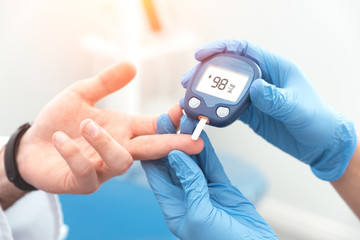Friday, March 20, 2020
Diabetes Symptoms
The following symptoms of diabetes are typical. However, some people with diabetes have symptoms so mild that they go unnoticed.
Common symptoms of diabetes:
Urinating often
Feeling very thirsty
Feeling very hungry—even though you are eating
Extreme fatigue
Blurry vision
Cuts/bruises that are slow to heal
Weight loss—even though you are eating more (type 1)
Tingling, pain, or numbness in the hands/feet (type 2)
Early detection and treatment of diabetes can decrease the risk of developing the complications of diabetes.
Although there are many similarities between type 1 and type 2 diabetes, the cause of each is very different. And the treatment is usually quite different, too. Some people, especially adults who are newly diagnosed with type 1 diabetes, may have symptoms similar to type 2 diabetes and this overlap between types can be confusing. Take our Risk Test to find out if you are at increased risk for having type 2 diabetes.
Symptoms of type 1 diabetes onset in an infant or child
The young child who is urinating frequently, drinking large quantities, losing weight, and becoming more and more tired and ill is the classic picture of a child with new-onset type 1 diabetes. If a child who is potty-trained and dry at night starts having accidents and wetting the bed again, diabetes might be the culprit.
Although it is easy to make the diagnosis diabetes in a child by checking blood sugar at the doctor’s office or emergency room, the tricky part is recognizing the symptoms and knowing to take the child to get checked. Raising the awareness that young children, including infants, can get type 1 diabetes can help parents know when to check for type 1 diabetes.
Sometimes children can be in diabetic ketoacidosis (DKA) when they are diagnosed with diabetes. When there is a lack of insulin in the body, the body can build up high levels of an acid called ketones. DKA is a medical emergency that usually requires hospitalization and immediate care with insulin and IV fluids. After diagnosis and early in treatment, some children may go through a phase where they seem to be making enough insulin again. This is commonly called the “honeymoon phase”. It may seem like diabetes has been cured, but over time they will require appropriate doses of insulin to keep their blood sugar levels in the normal range.
Symptoms of type 1 diabetes onset in adults
When an adult is diagnosed with diabetes, they are often mistakenly told that they have type 2 diabetes. This is because there is still a lack of an understanding in the medical community that type 1 diabetes can start at any age. It can also be tricky because some adults with new-onset type 1 diabetes are often not sick at first. Their doctor finds an elevated blood sugar level at a routine visit and starts them on diet, exercise and an oral medication. On the other hand, there are people who look like they have type 2 diabetes—they may be Latino or African American and/or overweight, but they have type 1 diabetes after all. This can be difficult for even the brightest doctor to diagnose.
Maybe it's a different type
If you or someone you know is diagnosed with type 2 diabetes but isn’t responding well to the typical treatments for type 2 diabetes, it may be worth a visit to an endocrinologist to determine what type of diabetes is happening. Generally, this requires antibody tests and possibly the measurement of a C-peptide level.
